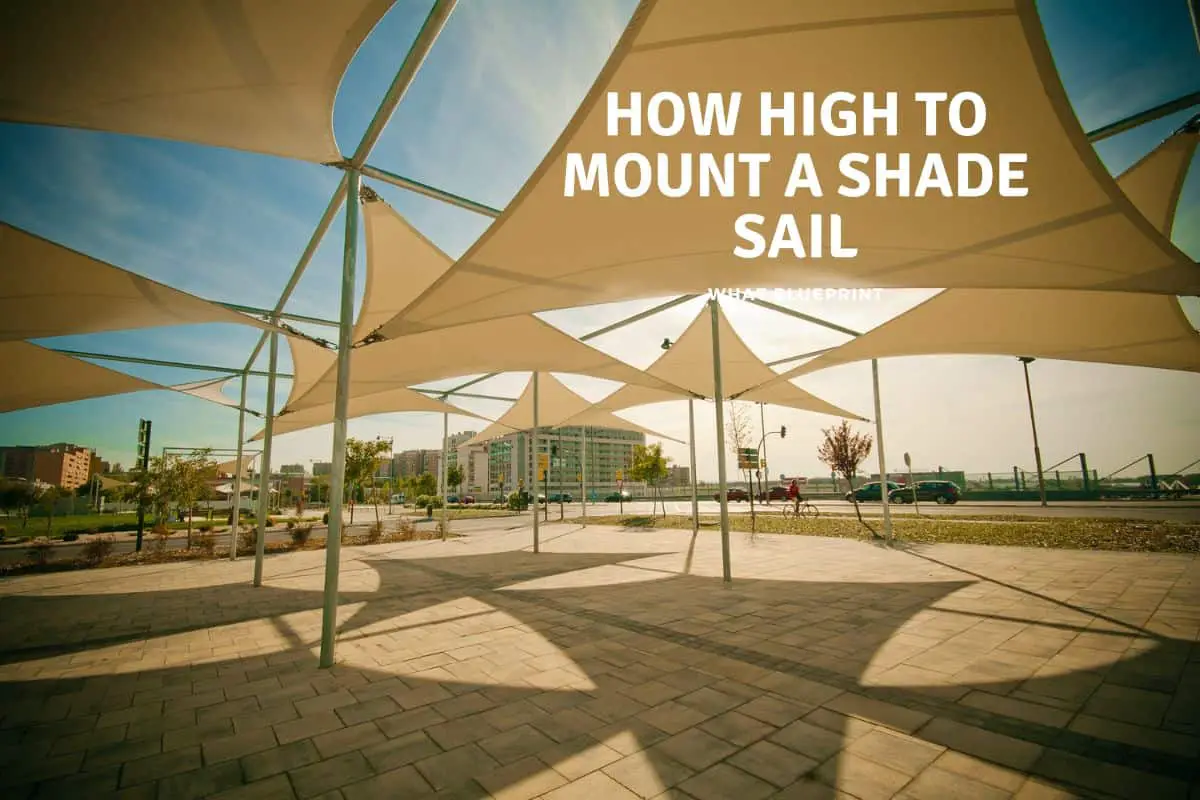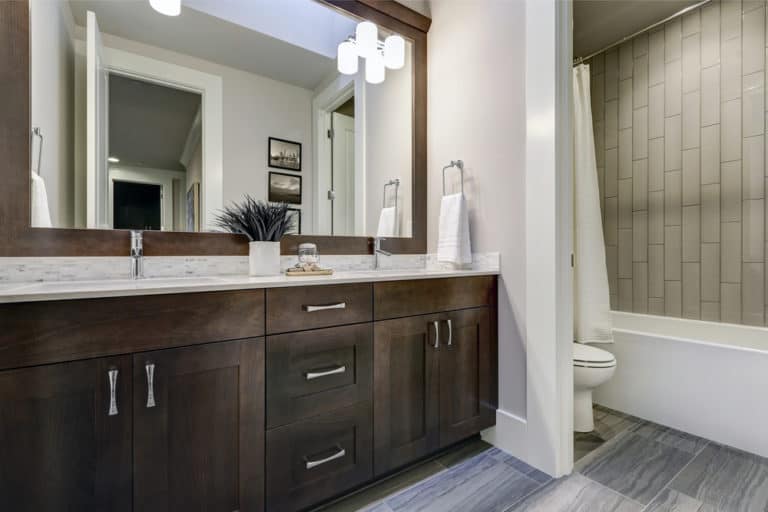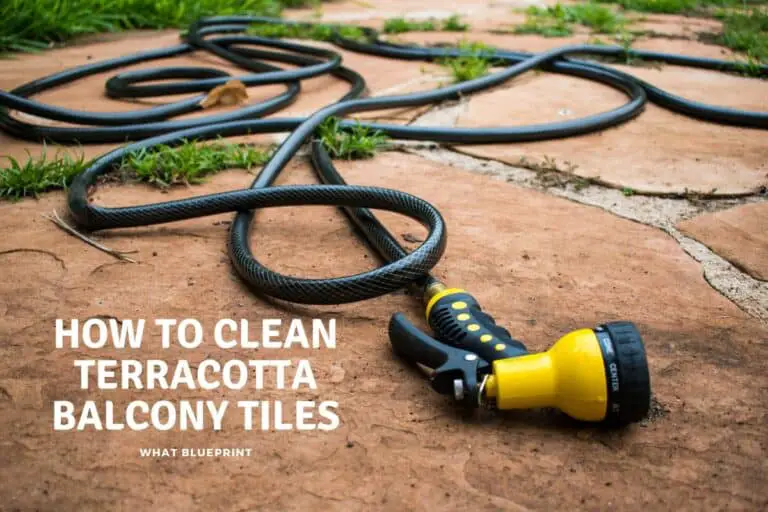How High To Mount Shade Sail
Living in a scorching location or in one where young children or the elderly require a space protected from the sun to enjoy the outdoors means you need shade. Sometimes, a covered patio or a dense tree will do the trick, but circumstances may require that you rig something yourself to protect your loved ones in the heat of the day. A sail is an obvious option, but how high should you mount a shade sail?
There is no set height restriction on mounting a shade sail. Ten-foot high at the lowest point is advisable if adults will be walking below. Any lower and the cooling effect will be negated. Using height variation, fix the opposing mount one foot higher for every five feet of span.
Having the ability to create shade wherever you want is desirable and relatively easy to execute. There are many commercial shade systems on the market, or you can simply use shade netting from a garden center if the span is not too large. I’d recommend no larger than 30’ x 30’ if using shade netting unless you live in a windy area. In this instance, the un-reinforced net will tear in time.
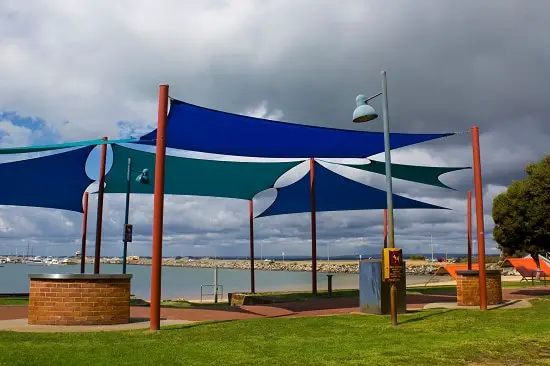
How High To Mount A Shade Sail?
Despite scouring the internet and chatting with several DIY experts, there seems to be no limit to the height you can go when mounting a shade sail. All of these experts brought up two factors, and I readily agree with both:
- The lowest point should be at least 35 inches above the head of the tallest person using it. The shade will block heat, but if you are close to it, you will not get the benefit of any cooling effect.
- Any poles should have 25% to 33% of their length buried in concrete for stability and should be angled away from the expanse of sail, thus providing additional strength.
If the shade sail is mounted too high, the area protected from the sun may be several yards away from the actual shade, depending on the sun’s angle. Midday might be fine, but mid-morning and mid-afternoon might find the sun shining into the target zone, negating any attempts to shade it.
If mounted too low, there will be less space between the shade and the people/plants beneath it for a cooling breeze to pass, and the efficiency of the sail will be compromised.
What Factors Might Influence The Stability Of My Shade Sail?
If you’ve ever seen a yacht or windsurfer in the grip of a strong wind, you’ll appreciate the value of ensuring that your sail never falls prey to this force of nature. Water is another factor that must be considered when erecting a sail. Rain, sleet, hail, and snow all need to be combatted, but this is easily done with a bit of foresight.
How Do I Ensure Precipitation Does Not Cause My Shade Sail To Fail?
Any flat surface will be prone to water issues as there is no runoff. In houses without sufficient roof gradient, pooling water will rust metal bolts and screws and try to find its way into the building. In the case of shade sails, the weight will cause the sail to bulge or even tear eventually, but this is avoided by height variation.
Water can be useful on a shade sail, and it is possible to look at installing misters to add that extra cooling factor to your outdoor space.
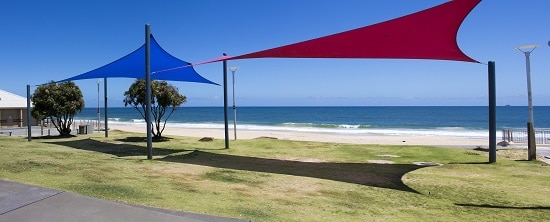
What Is Height Variation?
This is where you affix one or more mounting points at a different height to the rest. The effect is an immediate creation of runoff and provided that you mount the sail correctly, you will eliminate all typical precipitation problems.
There are several ways to create height variation, but for most purposes having opposing corners at the same height, but at a different height to the other opposing corners gives the best tension. In this scenario, the sum of the opposing forces results in tension throughout the sail and eliminates sagging.
A lovely alternative is to have every mounting point at a different height, which results in any number of lines from which water can shed. These methods prevent the sail from catching or flapping in the wind, which can sound like a bullwhip and spoil the ambiance you have tried to create.
How Much Height Variation Is Required?
To have the sail as practical as possible, I’d suggest a 20% – 25% increment, so for a 20’ x 20” shade sail – a standard size –, you’d have an increment of 4’ (20% of 20’) or one of 5’ (25% of 20’). This is just a guide, but one that seems to work best. For this, you might consider using seven-foot and ten-foot steel poles.
This ratio is not set in stone. Shadesailscanada recommends a height variation of 30% or more because this eases runoff and creates the illusion of several sails being used at once. The bottom line is you need a slope for the shedding of water, hail, and snow.
Protecting Your Sail During Winter
If you are living in a cold climate and experience snow each year, it is advisable to remove the shade sail every winter and, after cleaning, replace it in the warmer months when you see the sun once again.
In warmer climes, removing the sail is not practical due to year-round use (I’m jealous already!), but a hosing down with a mild detergent and a reasonably gentle broom-brushing can work wonders. This is particularly true if you have used a pale-colored shade sail.
Does The Color Of The Shade Sail Matter?
The lighter the color, the more it will reflect heat and the greater the cooling effect. However, if erected to the correct height, as discussed earlier, this will have no bearing on the temperatures beneath the sail.
A darker color will usually fade faster in the hot sun but will generally be more impressive when installed. Keep it cleaned by washing it in place each year, and make sure you rinse off all detergent, or the soap will do more damage than the sun and rain.
We have loads of information and articles on shading your outdoor space, while a search will help checking out the articles linked below is also a good way to start.
- Best potted plants for a shaded porch
- Deck shade ideas for windy areas
- What size posts for shade sails
- How high to mount a shade sail
- What knots for shade sails
- What pipes for shade sails
- Will shade sails kill grass
- How to shade balconies
- Best balcony privacy screens
Conclusion
A shade sail is – when you consider – an inexpensive way to erect an outdoor roof over a part of your garden, patio, or pool.
To combat expense, keep the size realistic if you wish, but anchor all poles and mounts exceptionally well and remember that height variation is vital.

